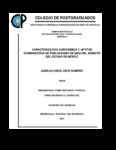| dc.description.abstract | El propósito de esta investigación fue contribuir a la detección de materiales genéticos adecuados de partida para el mejoramiento genético de maíz (Zea mays L) de grano blanco y blanco cremoso para el Sureste del Estado de México, así como definir el método de mejoramiento genético a seguir en las mismas. Para ello, se realizaron dos estudios; en el primero se evaluó el peso seco de grano por planta (PSG/PP), componentes del rendimiento, y características agronómicas de 110 materiales genéticos, mientras que en el segundo se estimaron los efectos de aptitud combinatoria general (gi) (ACG) y específica (sij)(ACE) del PSG/PP de 10 poblaciones sobresalientes y de sus 45 cruzas simples posibles, respectivamente, mediante el Método 2 de Griffing. En ambos estudios se usó un diseño de látice triple 10 x 11 con tres repeticiones en cuatro localidades del Estado de México, y la información obtenida se analizó con el modelo estadístico del diseño de bloques completos al azar haciendo un análisis combinado de localidades; adicionalmente, con los efectos de gi y sij se construyó la estructura genética del PSG/PP de cada cruza, para identificar las mejores poblaciones y las mejores cruzas. En el primer estudio se confirmó que las poblaciones nativas en general presentaron valores bajos en la mayoría de los componentes de rendimiento y del rendimiento mismo, y que algunas manifestaron características agronómicas no deseables. Por otro lado, en comparación con las poblaciones nativas, las poblaciones producto del premejoramiento, así como sus cruzas presentaron mejores componentes del rendimiento, mejor PSG/PP y características agronómicas deseables. Por su parte, las retrocruzas presentaron valores intermedios en rendimiento y características agronómicas no deseables, mientras que los maíces mejorados mostraron valores intermedios en rendimiento, y presentaron buenas características de planta, pero no de mazorca. Además, se detectarona los híbridos HS2 y Niebla como sobresalientes en rendimiento, y a Juchitepec como la localidad que reunió las condiciones óptimas para el cultivo del maíz. En el segundo estudio, el análisis de varianza combinando detectó significancia en la mayoría de las fuentes de variación, excepto en ACG. Las cruzas que mostraron los mayores efectos de ACE no siempre fueron las que tuvieron mayor PSG/PP.Las cruzas con efectos bajos de ACE no siempre presentaron bajo PSG/PP. Las cruzas de más alto rendimiento fueron aquéllas en las que cuando menos uno de los progenitores fue de alta ACG y sus efectos de ACE fueron altos y positivos. Las cruzas de bajo rendimiento fueron aquéllas en las que cuando menos uno de sus progenitores fue de baja ACG y sus efectos de ACE fueron negativos y de alto valor absoluto. En general, se identificaron materiales genéticos sobresalientes de partida para el mejoramiento genético del maíz en el Sureste del Estado de México, ya sea por selección o por hibridación. _______________ ABSTRACT: In order to contribute to detect highly productive varieties to start genetic improvement in maize (Zea mays L.) of white and white-cream colored kernel for the Southeast of the State of Mexico, as well as to define the breeding method to be implemented, two studies were carried out. In the first one, the grain yield per plant (PSG/PP), yield components, and some agronomic traits were evaluated in 110 different populations, while in the second one, ten outstanding maize populations and their 45 possible single crosses were evaluated for PSG/PP to estimate the general (gi) (GCA) and specific (sij) (SCA) combining effects of the populations and their single crosses,according to Griffing’s Method 2. In both studies, the populations were evaluated in a 10 x 11 triple lattice design with three replications at four locations in the State of Mexico, and a combined analysis of variance of data was performed using the statistical model of the randomized complete block design. Additionally, the genetic structure for each cross was constructed with the gi and sij estimates to identify the best populations and crosses. In the first study, it was confirmed that the native populations had low yields and low values for most of the yield components, and some of them had a bad agronomic performance. On the other hand, the populations subjected to pre-breeding as well as their crosses had better yields and yield components, as well as a better agronomic performance, than the native populations. Meanwhile, the backcrosses had intermediate yields and bad agronomic performances, while the improved populations had intermediate yields and good agronomic traits of plant but not of ear. Moreover, the hybrids HS2 and Niebla had the highest yields, and Juchitepec was the best location to grow maize. In the second study, the analysis of variance detected significance in most of the sources of variation, except in GCA. Crosses with the highest sij effects did not always have the highest PSG/PP, and those having low sij effects did not always have low PSG/PP. High yielding crosses were those in which at least one of the progenitors was of high GCA and had high sij effects. On the contrary, low yielding crosses were those in which at least one progenitor was of low GCA and its SCA effects were high and negative. According to results, it was possible to identify highly productive varieties to start a breeding program for the Southeast of the State of Mexico, using both selection and/or hybridization. | en_US |


